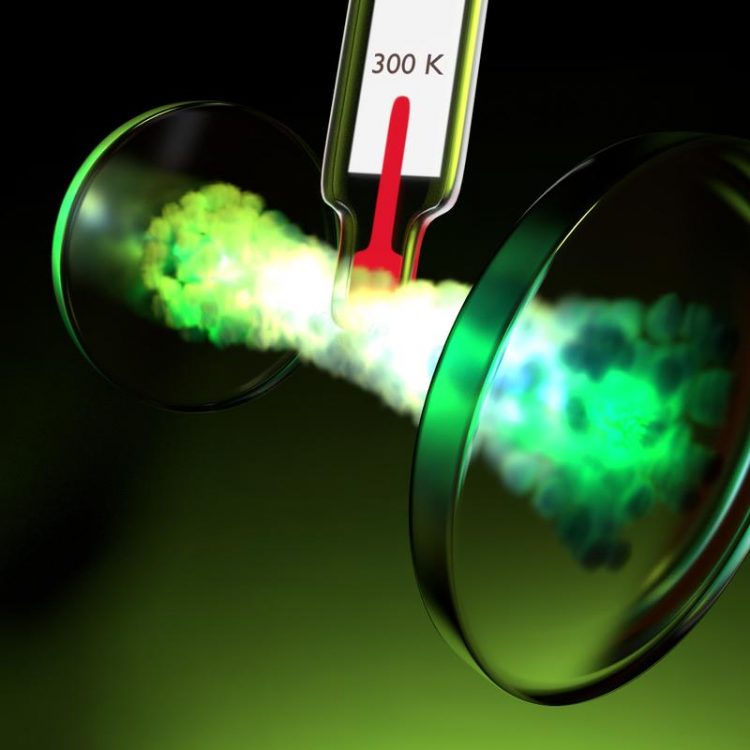Measuring the heat capacity of condensed light

Prof. Martin Weitz's team at the Institute of Applied Physics of the University of Bonn has measured the temperature of a gas of light, when it condenses. © Symbolic Image: Tobias Damm
Water vapor becomes liquid under 100 degrees Celsius – it condenses. Physicists speak of a phase transition. In this process, certain thermodynamic characteristics of the water change abruptly. For instance, at a single stroke, twice as much heat energy can be stored than in the gaseous state.
Light consists of tiny indivisible portions, the photons. Under certain conditions, they, too, can condense, if they are cooled enough. Many thousands of these light packets then suddenly fuse into a kind of super-photon with unusual characteristics – a so-called Bose-Einstein condensate.
Photon gas also changes heat storage characteristics abruptly
The physicists at the University of Bonn have now been able to show that the photon gas at this phase transition behaves according to the theoretical predictions of Bose and Einstein: Similar to water, it abruptly changes its heat storage capacity, meaning the ability to store thermal energy.
“This behavior was already known from condensed atoms”, explains Prof. Dr. Martin Weitz of the Institute of Applied Physics. “However, this is the first time that this phenomenon has been demonstrated for a condensate of light”.
Atoms, too, form a Bose-Einstein condensate, when they are cooled greatly and enough of them are simultaneously concentrated in a small space. They then suddenly become indistinguishable: They act like a single giant atom. Twenty years ago, physicists already demonstrated that the heat capacity of atoms suddenly changes at this phase transition. How strong this change is, however, can be measured only imprecisely for atoms. “In our condensate, this can be done substantially better”, emphasizes Dr. Jan Klärs, who has since moved from Bonn to ETH Zurich.
The heat capacity of a material is calculated from the energy needed to heat it by one degree. Usually this is done by measuring the temperature of the substance before and after adding a defined amount of energy. However, the temperature of a gas of light can not be measured with a thermometer; but that is also not necessary. “In order to determine the temperature of the gas, it is only necessary to know the different wavelengths of the light particles – the distribution of its colors”, says Klärs. And this can be determined with extreme precision with the methods available today.
“Our findings for the change in the heat capacity at the transition from photon gas to Bose-Einstein condensate match the theoretical predictions exactly”, explains Tobias Damm of the Institute of Applied Physics. “The precision of this method is so high that it is very suitable for precision measurement of certain natural thermodynamic constants”.
The heat content of the photon gas changes not only upon condensation to a super-photon, but also continuously with the ambient temperature. The Bonn physicists therefore hope that their findings can also be used to build high-precision thermometers.
Publication: Tobias Damm, Julian Schmitt, Qi Liang, David Dung, Frank Vewinger, Martin Weitz, & Jan Klärs: Calorimetry of a Bose-Einstein-condensed photon gas; Nature Communications, DOI: 10.1038/NCOMMS11340
Contact:
Prof. Dr. Martin Weitz
Institute of Applied Physics at the University of Bonn
Tel. ++49-228-73-4837 or -4836
Email: Martin.Weitz@uni-bonn.de
Tobias Damm
Institute of Applied Physics at the University of Bonn
Tel. ++49-228-73-3453
Email: damm@iap.uni-bonn.de
Dr. Julian Schmitt
Institute of Applied Physics at the University of Bonn
Tel. ++49-228-73-3453
Email: schmitt@iap.uni-bonn.de
Media Contact
More Information:
http://www.uni-bonn.deAll latest news from the category: Physics and Astronomy
This area deals with the fundamental laws and building blocks of nature and how they interact, the properties and the behavior of matter, and research into space and time and their structures.
innovations-report provides in-depth reports and articles on subjects such as astrophysics, laser technologies, nuclear, quantum, particle and solid-state physics, nanotechnologies, planetary research and findings (Mars, Venus) and developments related to the Hubble Telescope.
Newest articles

Silicon Carbide Innovation Alliance to drive industrial-scale semiconductor work
Known for its ability to withstand extreme environments and high voltages, silicon carbide (SiC) is a semiconducting material made up of silicon and carbon atoms arranged into crystals that is…

New SPECT/CT technique shows impressive biomarker identification
…offers increased access for prostate cancer patients. A novel SPECT/CT acquisition method can accurately detect radiopharmaceutical biodistribution in a convenient manner for prostate cancer patients, opening the door for more…

How 3D printers can give robots a soft touch
Soft skin coverings and touch sensors have emerged as a promising feature for robots that are both safer and more intuitive for human interaction, but they are expensive and difficult…





















